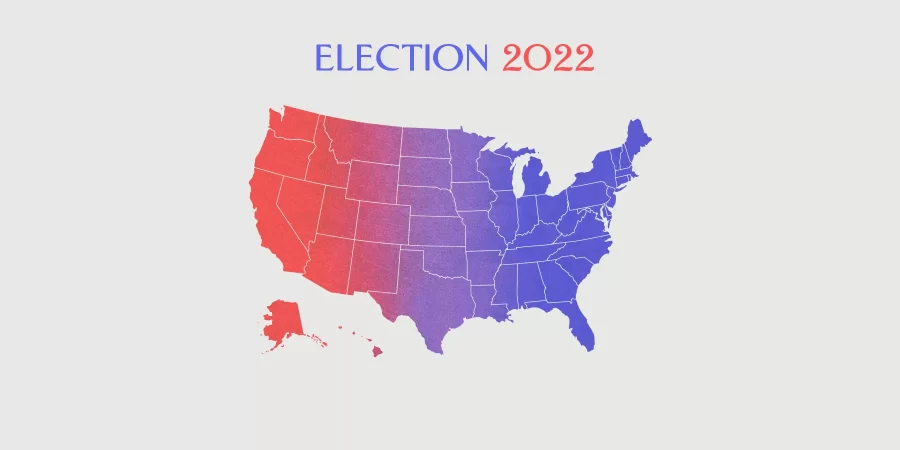The Red Wave Phenomenon Seems More Like A Lavender Haze
Prominent Republican politicians declared the 2022 midterms to be the resting grave for Democrats, as they predicted a red wave would unleash over the Democratic Party supposedly responsible for America’s demise. However, the race for the control of both chambers has not concluded yet, with results being tighter than expected, showing more of a lavender haze than a red wave.
In spite of low turnout throughout history, Midterm races are crucial because the races give a glimpse into what the next presidential election could turn out to be as the midterms are held two years before: in favor of the Democrats or the Republicans? Although Democrats were leading in the polls over the summer for keeping control of the Senate and the House, the tide managed to turn in favor of Republicans taking control of both chambers. The party in charge of the White House typically fares poorly in the midterms, with Trump losing 40 seats in 2018. Pollsters were certain Republicans would win a clear majority in the House, with FiveThirtyEight’s Nathaniel Rakich estimating Republicans had an 84 in 100 chance of capturing the House based on his simulation.
According to the current CNN forecast prediction, Republicans have a chance of winning 222 seats in the House. That is only four seats more than the majority needed to take control, which does not necessarily represent a red tsunami as predicted. Many competitive House races were won by Republicans, but some key races were won by Democrats.
Congresswoman Jennifer Wexton of Virginia’s 10th district won her race against Navy Seal Hung Cao by five percentage points, while the race in Virginia’s 7th district encompassing Fredericksburg and parts of southern Prince William County was much tighter: three percentage points between Democratic incumbent Abigail Spanberger and Republican Prince William County Chair Supervisor Yesli Vega. Instead of a complete blue or red wave, the electorate chose to blend the two parties together to create a purple bipartisanship. Many voters voted split-tickets, e.g. a Republican senator and a Democrat governor.
One thing is certain: polls and simulations are not always accurate. Pollsters were also certain in 2016 that Hillary Clinton would win the presidency, but the election ended up in the opposite direction. What is certain, however, is a large swath of Generation Z and people of color (POC) voters showed up to vote and were potentially responsible for the tight margins in even reliably red districts, such as Colorado’s 3rd district where the ultra-MAGA Representative Lauren Boebert faces a tough challenge.
The 3rd district is not unique – voters are making history this year by electing a variety of diverse candidates. A historic number of LGBTQ+ candidates were elected to office, with Governor-elect Maura Healey of Massachusetts becoming the first open Lesbian governor in the US and James Roesener becoming the first transgender man elected as a state representative. Governor-elect Wes Moore of Maryland became the first Black governor in a state that is the first to shift majority minority demographically and is only the third Black governor in the history of the United States.
The Democratic Party is not alone in promoting diverse candidates – Republicans Katie Britt became Alabama’s first female senator and Sarah Huckabee Sanders became Arkansas’ first female governor.
Generation Z also cashed in in some of the wins – Florida’s Maxwell Frost became the first Gen Z member of Congress, while progressives Summer Lee and John Fetterman of Pennsylvania won their races: Fetterman even flipped a Republican senate seat in by three percentage points.
Despite history being made, there have been no exit polls called in favor of either party. Republicans Ron DeSantis and Marco Rubio won their races by 10+ point margins in Florida, but their victories are not accurate representations of how the entire Republican Party is currently faring nationally. Republicans may gain a slim margin in the House, but the Senate is still considered a toss-up, meaning either party could gain the majority. The control of the Senate is up to three key races: Arizona, Nevada and Georgia. Georgia’s race between pastor Raphael Warnock and former football player Herschel Walker ended in a run-off set for December 6, but ballots are still being counted in Arizona and Nevada.
Republican Adam Laxalt is leading in Nevada by only 15,000 votes, while Democratic incumbent Mark Kelly is facing a fairly easy rematch against Republican Blake Masters who was caught under fire for once posting pro-Nazi commentary. However, the slow vote-counting in Arizona and Nevada has led to widespread conspiracies of election fraud, including from Republican gubernatorial nominee Kari Lake.
Lake and other election deniers fail to consider the historical implications of the Arizona race – a record number of 290,000 mail-in ballots were dropped off at each respective voting center on election day. Election officers have to verify the signatures and go through a stringent process to ensure every vote is counted.
Nevertheless, Generation Z and POC voters have proven to pollsters, politicians and simply the entire electorate that they are a force to be dealt with. Candidate quality is a number one factor in ensuring control of either chamber, and with election deniers on the ballot, perhaps voting blue seems like the safest option for some. Needless to say, the red wave is not turning out the way Republicans imagined before the midterms.


